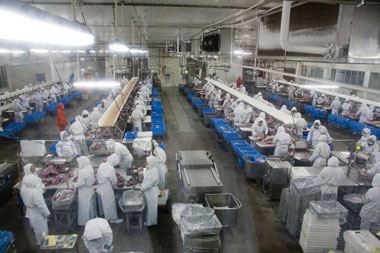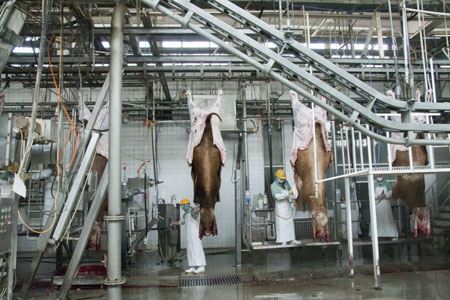|
Efforts Seek To Re-Open China’s Markets To U.S. Beef By Years End
2nd In A Series
JOHN M. LAROSE &
BETTY VALLE-GEGG NAEGER
MidAmerica Farmer Grower
SHENYANG, CHINA
The U.S. agricultural trade mission to China in May, which was led by Michael Scuse, Under Secretary USDA, had on its agenda visit’s to cattle facilities in China.
The group visited a cattle farm that specialized in the crossbreeding of cattle in an effort to produce the highly marbled beef the Chinese market desires as well as a beef processing facility.

Shown is one of the assembly lines for meat processing at the Haoyue facility.
Photo by John LaRose

A model of an industrial park being built surrounding Haoyue. This park will supply all red meat and meat by-products.
Photo by John LaRose
“Since the Bovine Spongiform Encephalopathy (BSE) case in 2003, we have not been able to get beef products back into China. That’s one problem we currently are working to change,” said Scuse.
“China’s Vice Premier made a commitment to U.S. Secretary of Agriculture Tom Vilsack last November to open up the beef market to the United States this year.”
Following the agricultural trade mission, Scuse traveled to Beijing for official meetings to discuss the elimination of China’s ban on U.S. beef imports due to the 2003 reported appearance of Bovine Spongiform Encephalopathy (BSE) in the U.S.
At that time (2003) beef was not a main part of the Chinese diet, so the United States farmers lost only a small part of its exports. However, today there is an enormous surge of foreign beef streaming into China with Australia, Uruguay, New Zealand, and Canada being the top four suppliers.
“It’s frustrating to know that China's demand for high-quality beef is growing stronger every day, but U.S. cattle producers don’t have access to this, the fastest-growing and potentially largest beef market in the world,” stated Joel Haggard, senior vice president of the U.S. Meat Export Federation (USMEF) for the Asia Pacific region during an interview with MAFG.

Joel Haggard, senior vice president of the U.S. Meat Export Federation
for the Asia Pacific region explained China’s demand for beef is growing
stronger but U.S. cattle producers currently do not have access to this market.
“When China closed its market to U.S. beef as a result of the December 2003 BSE case, beef was still a minimal part of the Chinese diet. But this has changed dramatically in recent years and months,” he said.
“China’s year over year beef import volume in 2012 exploded by 164 percent to 70,574 metric tons,” said Haggard.
“More recently, in 2013, the surge is even more impressive. I think it surprised everyone, moving into the hundreds of thousands of tons from previously tens of thousands of tons, which is mostly grass fed,” said Haggard.
“The import surge of beef continued into China in the first quarter of 2014 with imports up 44 percent year on year. China also reported an almost 2 percent increase in domestic beef production in 2013 to 6.7 million metric tons.”
“U.S supply’s a different type of product, grain fed, so everyone can benefit. There’s a growth in overall demand for beef consumption and increased demand for grain fed beef, because of their increased interests in steaks, but also other dry cooking techniques.”
With demand for beef exploding in China, U.S. negotiators are working feverishly to break down barriers and be a part of this market.
“Demand has gotten very high and continues to grow by leaps and bounds, so it’s important that the United States becomes a beef supplier in the Chinese market,” said Haggard. He said he finds the Chinese beef market very interesting. “We're currently excluded from shipping beef to China, but our government negotiators are working on a deal and we hope to have one soon,” he stated.
“They’re short of beef in China. Beef prices are a record high here, way above the USDA average cutout prices, so we think there's a very good opportunity here with per capita consumption expanding fast.”
He attributed that to urbanization, income growth, expansion of chain restaurants, expansion of western retail, expansion of online retail, embracement of luxury foods. That's all part of the equation.
“We've been out of the China market for 10 years and we'd like to get back in,” said Haggard. “I think the market is big and can accommodate all suppliers. I think everyone can benefit because of this rise in consumption.”
“There's a growth in overall demand for beef consumption in China, but there's also a growth in demand for grain fed beef because of an increased interest in steaks, but also other dry cooking techniques such as, barbeque and hot pots. The United States is particularly suited to supply large volumes of single cuts of those items to China,” Haggard continued.

Haoyue is a beef production company in Changchun, China. It is the dominant supplier of China’s domestic beef
market as well as supplying over half of China’s total beef exports to southeast Asia, east Europe, Africa and Russia.
Photo by John LaRose
He feels that U.S. beef products in many forms would be acceptable, once the ban is lifted. The beef imported now from other countries is mostly grass fed cuts, boneless, frozen, with some chilled beef imported last year.
“It’s not a question of imports versus domestic; both can thrive here simply because of that fast growth in consumption. It will benefit the entire cattle industry all across the United States,” said Haggard. He expects the products to be shipped will be grain fed beef, and a range of cuts.
China’s domestic production supplies about 90 to 95 percent of its consumption. Though it’s hard to calculate, statistics show China was producing somewhere between 5 and 6 million metric tons, and they import between 250,000 to 300,000 metric tons of beef.
“What's difficult to know, and I think even the Chinese industry would admit, is because the beef industry here is comprised of many small holders, it’s very difficult to get accurate data on what actual beef production is,” he noted.
“They’re a major beef consumer now despite the fact that the per capita consumption is still low; and that's why it's a very attractive prospect for us because we think beef consumption will continue to increase,” he added.
While Chinese cattlemen also are looking at expanding their herds, at this point the government is not supporting this industry.
“The question we’re trying to answer ourselves is the extent to which the government will support this industry, as it has other livestock sectors such as dairy, pork and poultry,” Haggard said. “They have in the past, but it's been modest compared to what they’ve done with the other livestock industries.”
With government support, there is concern that in the future they could supply all their own meat. Some Chinese academics are looking at this issue, but they presently feel that since beef is not a commonly consumed meat and it does require a lot of land and grain resources, that’s not likely. China is short of grain and, to them, food security involves high levels of self sufficiency. China has water pollution problems and a lot of soil is contaminated with cadmium, nickel and arsenic. It’s a complicated issue.
With the present state of Chinese trade, many are curious about what will happen this year whether the phenomenal, triple, hundreds of percentage growth will be sustained. “Prices rose through the year last year in China despite the fact that imports were coming in; and the self sufficiency rate is still pretty high there for beef so it’s not like they’re becoming reliant on imports yet, but from a price standpoint those imports did make sense,” Haggard said.
“All beef producing and major exporting countries are looking at the China market now, especially those banned from shipping, mainly the United States, India and Brazil are very interested. They just need to get access,” he added.
As access becomes available it’s expected the price of beef in China will drop. However, that also depends on the volume that’s arriving.
“I think that will help bring down the price but it was quite interesting why last year we saw those prices go up as the import volumes reached this phenomenal record,” Haggard summed. ∆
Watch for the interview with Michael Scuse, the Under Secretary of Agriculture USDA, which will be published in the June 27th issue of MAFG.
JOHN M. LAROSE: Publisher, MidAmerica Farmer Grower
BETTY VALLE GEGG-NAEGER: Senior Staff Writer, MidAmerica Farmer Grower
|
|